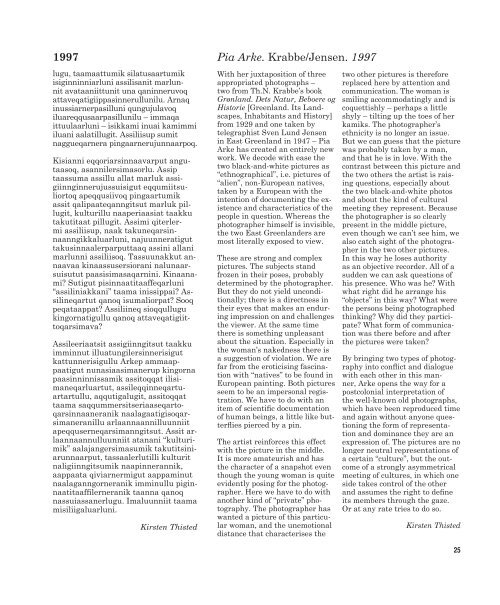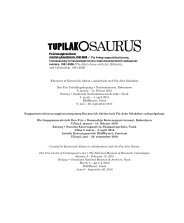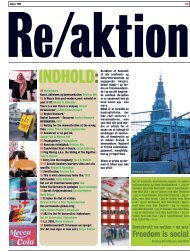tupilakosaurus - Print matters!
tupilakosaurus - Print matters!
tupilakosaurus - Print matters!
Create successful ePaper yourself
Turn your PDF publications into a flip-book with our unique Google optimized e-Paper software.
1997<br />
lugu, taamaattumik silatusaartumik<br />
isiginninniarluni assilisanit marlunnit<br />
avataaniittunit una qaninneruvoq<br />
attaveqatigiippasinnerullunilu. Arnaq<br />
inussiarnerpasilluni qungujulavoq<br />
iluareqqusaarpasillunilu – immaqa<br />
ittuulaarluni – isikkami inuai kamimmi<br />
iluani aalatillugit. Assiliisup sumit<br />
naggueqarnera pingaarnerujunnaarpoq.<br />
Kisianni eqqoriarsinnaavarput angutaasoq,<br />
asannilersimasorlu. Assip<br />
taassuma assillu allat marluk assigiinnginnerujussuisiguteqqumiitsuliortoq<br />
apeqqusiivoq pingaartumik<br />
assit qalipaateqanngitsut marluk pillugit,<br />
kulturillu naaperiaasiat taakku<br />
takutitaat pillugit. Assimi qiterlermi<br />
assiliisup, naak takuneqarsinnaanngikkaluarluni,<br />
najuunneratigut<br />
takusinnaalerparputtaaq assini allani<br />
marlunni assiliisoq. Tassuunakkut annaavaa<br />
kinaassusersiorani nalunaarsuisutut<br />
paasisimasaqarnini. Kinaanami?<br />
Sutigut pisinnaatitaaffeqarluni<br />
“assiliniakkani” taama inissippai? Assilineqartut<br />
qanoq isumaliorpat? Sooq<br />
peqataappat? Assiliineq sioqqullugu<br />
kingornatigullu qanoq attaveqatigiittoqarsimava?<br />
Assileeriaatsit assigiinngitsut taakku<br />
imminnut illuatungilersinnerisigut<br />
kattunnerisigullu Arkep ammaappaatigut<br />
nunasiaasimanerup kingorna<br />
paasinninnissamik assitoqqat ilisimaneqarluartut,assileqqinneqartuartartullu,<br />
aqqutigalugit, assitoqqat<br />
taama saqqummersitseriaaseqartoqarsinnaaneraniknaalagaatigisoqarsimaneranillu<br />
arlaannaannilluunniit<br />
apeqquserneqarsimanngitsut. Assit arlaannaannulluunniit<br />
atanani “kulturimik”<br />
aalajangersimasumik takutitsiniarunnaarput,<br />
tassaalerlutilli kulturit<br />
naligiinngitsumik naapinnerannik,<br />
aappaata qiviarnermigut aappaminut<br />
naalaganngorneranik imminullu piginnaatitaaffilerneranik<br />
taanna qanoq<br />
nassuiassanerlugu. Imaluunniit taama<br />
misiliigaluarluni.<br />
Kirsten Thisted<br />
Pia Arke. Krabbe/Jensen. 1997<br />
With her juxtaposition of three<br />
appropriated photographs –<br />
two from Th.N. Krabbe’s book<br />
Grønland. Dets Natur, Beboere og<br />
Historie [Greenland. Its Landscapes,<br />
Inhabitants and History]<br />
from 1929 and one taken by<br />
telegraphist Sven Lund Jensen<br />
in East Greenland in 1947 – Pia<br />
Arke has created an entirely new<br />
work. We decode with ease the<br />
two black-and-white pictures as<br />
“ethnographical”, i.e. pictures of<br />
“alien”, non-European natives,<br />
taken by a European with the<br />
intention of documenting the existence<br />
and characteristics of the<br />
people in question. Whereas the<br />
photographer himself is invisible,<br />
the two East Greenlanders are<br />
most literally exposed to view.<br />
These are strong and complex<br />
pictures. The subjects stand<br />
frozen in their poses, probably<br />
determined by the photographer.<br />
But they do not yield unconditionally;<br />
there is a directness in<br />
their eyes that makes an enduring<br />
impression on and challenges<br />
the viewer. At the same time<br />
there is something unpleasant<br />
about the situation. Especially in<br />
the woman’s nakedness there is<br />
a suggestion of violation. We are<br />
far from the eroticising fascination<br />
with “natives” to be found in<br />
European painting. Both pictures<br />
seem to be an impersonal registration.<br />
We have to do with an<br />
item of scientific documentation<br />
of human beings, a little like butterflies<br />
pierced by a pin.<br />
The artist reinforces this effect<br />
with the picture in the middle.<br />
It is more amateurish and has<br />
the character of a snapshot even<br />
though the young woman is quite<br />
evidently posing for the photographer.<br />
Here we have to do with<br />
another kind of “private” photography.<br />
The photographer has<br />
wanted a picture of this particular<br />
woman, and the unemotional<br />
distance that characterises the<br />
two other pictures is therefore<br />
replaced here by attention and<br />
communication. The woman is<br />
smiling accommodatingly and is<br />
coquettishly – perhaps a little<br />
shyly – tilting up the toes of her<br />
kamiks. The photographer’s<br />
ethnicity is no longer an issue.<br />
But we can guess that the picture<br />
was probably taken by a man,<br />
and that he is in love. With the<br />
contrast between this picture and<br />
the two others the artist is raising<br />
questions, especially about<br />
the two black-and-white photos<br />
and about the kind of cultural<br />
meeting they represent. Because<br />
the photographer is so clearly<br />
present in the middle picture,<br />
even though we can’t see him, we<br />
also catch sight of the photographer<br />
in the two other pictures.<br />
In this way he loses authority<br />
as an objective recorder. All of a<br />
sudden we can ask questions of<br />
his presence. Who was he? With<br />
what right did he arrange his<br />
“objects” in this way? What were<br />
the persons being photographed<br />
thinking? Why did they participate?<br />
What form of communication<br />
was there before and after<br />
the pictures were taken?<br />
By bringing two types of photography<br />
into conflict and dialogue<br />
with each other in this manner,<br />
Arke opens the way for a<br />
postcolonial interpretation of<br />
the well-known old photographs,<br />
which have been reproduced time<br />
and again without anyone questioning<br />
the form of representation<br />
and dominance they are an<br />
expression of. The pictures are no<br />
longer neutral representations of<br />
a certain “culture”, but the outcome<br />
of a strongly asymmetrical<br />
meeting of cultures, in which one<br />
side takes control of the other<br />
and assumes the right to define<br />
its members through the gaze.<br />
Or at any rate tries to do so.<br />
Kirsten Thisted<br />
25




